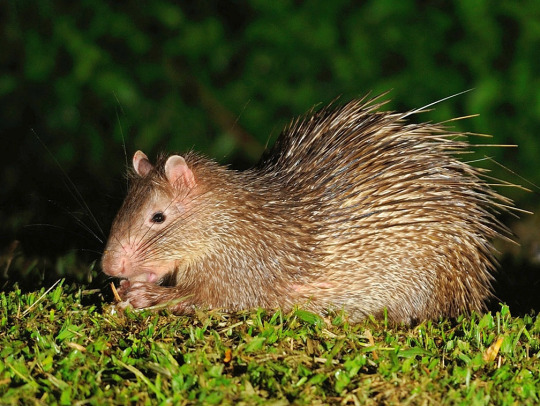#asiatic brush-tailed porcupine
Text
Animal of the Day!
Asiatic Brush-tailed Porcupine (Atherurus macrourus)

(Photo in public domain)
Conservation Status- Least Concern
Habitat- Southern Asia
Size (Weight/Length)- 80 cm
Diet- Leaves; Bark; Fruits; Flowers; Roots; Nuts; Seeds
Cool Facts- The Asiatic brush-tailed porcupine loves the tropics, sticking to bamboo and palm forests. They find themselves at home in thick underbrush where burrows keep them safe. Multiple Asiatic brush-tailed porcupines can end up living in the same burrow system, working together to defend their home from predators. They are generally nocturnal and spend only a few hours each night outside of their burrow. When encountering a predator, these porcupines can run as fast backwards as they can forwards. This results in a leopard or human being embedded with hundreds of quills.
Rating- 12/10 (The rarest porcupines of South Asia.)
#animal of the day#animals#mammals#rodents#porcupine#monday#january 8#asiatic brush-tailed porcupine#biology#science#conservation#the more you know
96 notes
·
View notes
Text
Asiatic brush-tailed porcupine

https://www.youtube.com/watch?v=i8ZgDLjEcGw
1 note
·
View note
Text
WEIRD RODENT WEDNESDAY
Week #6- Asiatic Brush-Tailed Porcupine
Asiatic brush-tailed porcupines are an Old World porcupine species that live across southeast Asia. They are very rat-like in appearance and weigh about six pounds- much smaller than most other porcupines. They have short legs with webbed feet and blunt claws, and can run, climb, and even swim. Their tail is mostly naked but with a brush of spines at the end, giving them their name.

They have spines over pretty much all of their body, but the ones on their face, legs, and underside are softer. The sharp, long spines along their backside do a pretty good job of deterring predators, but big cats, dholes, and domestic dogs are known to try and hunt them. They are also hunted for their meat by humans. (Apparently they taste pretty good!) When threatened, the brush-tailed porcupine shakes its tail, producing a rattling sound to warn predators away.

These rodents are quick and cautious, only leaving their burrows at night to forage for food. They are primarily herbivorous- enjoying a variety of plants, nuts and seeds, tree bark, and fruit- but they won’t turn down a meal of insects or carrion. They are very adaptable and can live in a variety of habitats, as long as there is enough food to support them, but they favor forested areas near rivers or streams. They usually forage alone, but they live in small family groups and sleep together in communal dens. They are very good diggers, and their burrows can have tunnels that are over ten feet long.

Asiatic brush-tailed porcupines are born small but well-developed, able to see, hear, and move around shortly after birth. Porcupines are born already armed with a coat full of quills, but they are soft and rubbery at first (I’d hate to be a porcupine mom if they weren’t). After about an hour or so, they harden into sharp spines. Gestation lasts about 100 days, with one or two babies being born at a time. The babies are weaned by about 2 months of age, though they will stay with their parents for a year or longer. Male brush-tailed porcupines are involved in parenting and will take the kids out to forage and watch over them.

Thank you for taking the time to read about this cool rodent! Check back next week for another installment :)
image sources: x x x x
86 notes
·
View notes